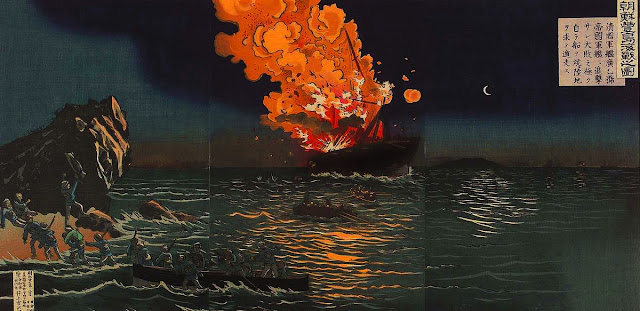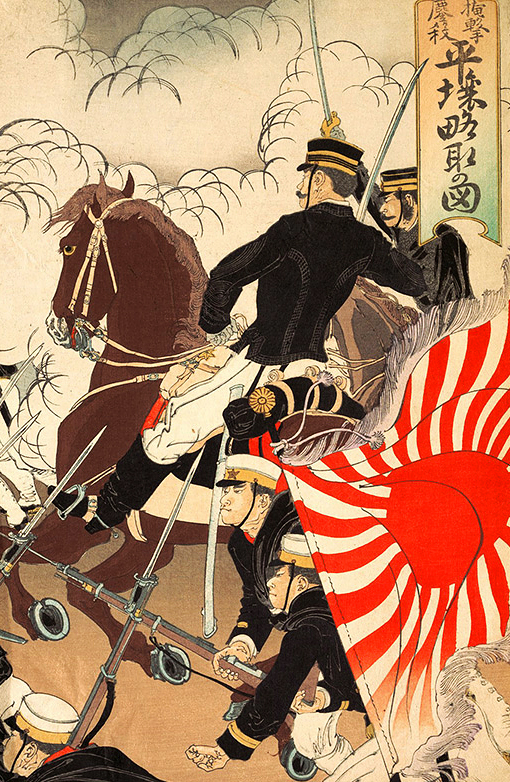Overview: The Rapid Modernization of Meiji Japan 明治维新(甲午)
Ceremony for the Promulgation of the Constitution of Japan, 1889, In only 3 decades
since Japan was forced to open up to western powers, the nation has rapidly modernized
into an ambitious power.
This chapter is a brief overview, and is a reference page that will be part of the greater chapter about the Beiyang Navy and the lead up to the naval battles of the 1st Sino- Japanese War. Here we will cover the rapid strides Meiji Japan has made since their contact with western powers.
Since the 1600s, the Japanese under the Tokugawa Shogunate had pursued over 260 years of isolation with the rest of the world and peace with its Asian neighbors. However the catastrophic defeats Qing China suffered at the hands of the western empires greatly alarmed the leaders in Japan- and thus also shaped their political outlook for the next century. Unlike the stubbornly defiant Qing- who tried repeatedly (and failed) to resist the incoming foreigners, Japan tactically submitted to the westerners and rapidly transformed themselves to become more like the western powers.
Black Iron Behemoth: In this mid 19th century painting, the Japanese artist depicted the iron hulled and steam-powered paddle ships as if it's a floating monster. It is through the native's eyes that we understand how they regarded the coming foreigners as monsters astride on top of monstrous ships.

Despite having only arrived with a relatively small fleet, Commodore Matthew Perry made such an impression upon the Japanese with his iron-hulled steam ships: the "Kurofune" (lit. "Black Ships") made the Japanese believe that he was a powerful God- like conqueror. The acquiescence of the Shogunate to the Americans and other western powers in a series of unequal treaties would greatly humiliate and de-legitimize the Shogunate and usher in its destruction at the hands of the imperial Meiji faction. The the rhetoric of 尊皇攘夷 "Revere the Emperor, Expel the Barbarians" (itself an allusion based on a Zhou dynasty chant) was used to stoke nationalist fervor. However, the architects of the Meiji Restoration would cleverly use this fervor to modernize Japan.
Emperor Meiji, his-wife and Prince-Haru in western clothing, such artworks not only have distinct commercial values for collection but also served as encouragements for the commoners to embrace western clothing- after all, if the revered Emperor and the imperial family have assimilated to the new norm, why not his loyal subjects?
View of Takanawa Ushimachi under the Shrouded Moon, 1879
Perhaps more so than any other Japanese branches that modernized, was the Japanese army: In 1873, compulsory military education was implemented throughout the country where all young adult males were forced to be educated in the military for 3 years. The newly conscripted Japanese infantry were trained along German lines by German officers. Comparatively, the Imperial Japanese Navy was modeled after the British Royal Navy, at the time the foremost naval power. British advisers were sent to Japan to train the naval establishment, while Japanese students were in turn sent to Britain to study and observe the Royal Navy. Through drilling and tuition by Royal Navy instructors, Japan developed naval officers expert in the arts of gunnery and seamanship. At the start of the 1st Sino- Japanese War, the Imperial Japanese Navy comprised a fleet of 12 modern warships.
However it should also be mentioned that all of the internal reforms in imitation of the completely foreign aggressors were deeply unpopular with the citizenry- especially the forced introduction of compulsory western education for both boys and girls. This policy was so unpopular that in one year alone over 2000 of such local schools were torched to the ground by the angry mobs. And the previously stated compulsory military education for all conscripted Japanese males saw more a dozen riots in the 1870s that attacked registration centers.
Shinbashi Railway Station, Kobayashi Kiyochika 1881
But despite these protestations, the government moved on with their reforms- through a keen understanding of achieving parity with western powers and simultaneous internal repression to achieve said aims. In such a way, Japan paved forward with its modernization with the ultimate intention of making Japan an equal to the Western powers. However, this zeal to achieve parity to the western empires would have its own local consequences. Namely, when the Japanese industrialists and government needed to secure new resources to power up the rising state, they began to look else where to their neighbors.
After having observed the sheer global- spanning size of many of the European powers and in an attempt to emulate them, Japan soon began to look out beyond its own periphery, in 1869, Japan annexed Hokkaido in northern Japan and incorporated it as part of the nation, in 1874, Japan attacked Qing held Taiwan and forced the Qing to apologize and pay them for the invasion of the island, and in 1879 Japan forcibly annexed Okinawa by deposing its Ryukyuan King and subjugated its native population. By the 1890s, the Japanese set their sight on Taiwan and Korea, and sought to dislodge both from Qing dynasty's control. And it was here- in respect to the internal politics of the Korea that war broke out between the Qing dynasty and Japan.
THE 1ST SINO-JAPANESE WAR
Map of Korea in 1822: The 1st Sino- Japanese War erupted over the control of Korea. Korea had been a historical tributary state of various Chinese dynasties, but Japan- at the behest of its merchants and its nationalists attempted to influence Korean politics through rival political factions within the Korean court for better deals, concessions, and direct political influence. Initially both the Qing and the Japanese conflicted through the struggles of the factions in the Korean court, then- then supported various rebel groups in order to influence the country through proxy wars. Until finally, open hostility erupted between the 2 empires.
→ ☯ [PLEASE SUPPORT ME @ PATREON] ☯ ←
Thank you to my Patrons who has contributed $10 and above: You made this happen!
➢ ☯ MK Celahir
➢ ☯ Vincent Ho (FerrumFlos1st)
➢ ☯ BurenErdene Altankhuyag
➢ ☯ Stephen D Rynerson
➢ ☯ Michael Lam
➢ ☯ Peter Hellman























Comments
By contrast, the Boshin war was very short and not very bloody at all, some battle near the imperial capital and a march to the north to paficy Aizu and you have Japan remade and most of the warlords tilting their head to the rising imperial forces. Where as in the Qing there were so many huge rebellions that caused millions to die for nothing- in the 50 years that followed the Manchus were still able to maintain nominal control. The fact that Japan chose humble humiliation- but all the while kept their focus on the bigger picture of reforming themselves really spared them huge amount of needless pain. The fact that China didn't is one of the many reasons that China and the west are still at each other's throat today.
I myself don't think it would work in the long term bc anything democratic against a sitting minority of Manchus would just legally eject them out of power. So in terms of game theory and voting power they are never going to allow it. However this ironclad conservative attitude + endless rejection of reformers just made the Qing an obstacle that must be removed to get some of the much needed reforms done.
However I will say they were working with a extreme crunch. It's literally do or die, and none of their neighbors could give them any blueprints so they raced ahead right into the heart to Europe to learn what must need to be learned in order to survive. As an island nation they immulated British traditions and their naval ways, for land armies they also learned from the strongest out there (who else are they going to learn from? Russians? who were still regarded as backwards even among the Europeans? who had way too much lands of Mongolic people to govern?) and in business they learned from the Anglos and the Americans. I think the meme worthy term "Stronk" should be applied here. Japan needed ____ = Stronk. And they opted to learn from the best to make something out of themselves.
That said, as a Chinese person who knows people whose grandparents were seriously screwed over by Japan's conquests from both Mainland China, Taiwan, Singapore, as well as Malaysia even though I understand how they came to be- and what they needed to reform internally, I don't condone it. What he did to Okinawa, Korea, and the Qing was naked aggression, considering that all 3 have never invaded Japan. In fact, no native Chinese dynasty has ever invaded Japan throughout both culture's LONG history. Nor will I tolerate most of the weeb revisionists out there who buys the Japanese narrative fully without even raise a critical brow